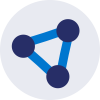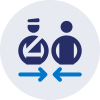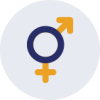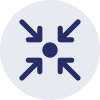Key Operational IASC Guidance
Catalogue
IASC Protocols, Standard Operating Procedures, and Terms of Reference
-
Humanitarian System-Wide Scale-Up Activation: Definition and ProceduresProtocol 1 of the Scale-Up activation documents defines and establishes the procedures for a humanitarian system-wide Scale-UP activation in response to a major sudden-onset crisis and/or substantial deterioration of a humanitarian situation.
-
‘Empowered Leadership’ in a Humanitarian System-Wide Scale-Up ActivationProtocol 2 of the Scale-Up activation document serves as guidance on the Humanitarian Coordinator’s empowered leadership following an IASC Scale-Up activation.
-
Protocol for the Control of Infectious Disease Events. Humanitarian System-Wide Scale-Up ActivationThis protocol outlines the IASC procedures for the assessment of infectious disease events, the consultation and decision-making processes on Scale-Up activation, the activation and deactivation criteria and procedures, and implications for IASC members and other key collaborating organizations.
-
Standard ToR for Humanitarian Country Teams (HCTs)These standard Terms of Reference (ToR) for Humanitarian Country Teams (HCTs) are the foundation for developing country-specific HCT ToR that are adapted as necessary. The ToR define the roles and responsibilities for participation and functioning of HCTs. They also reinforce the reciprocal and mutual accountabilities of the Humanitarian Coordinator (HC) and HCT members.
-
Saving Lives Together: A Framework for Improving Security Arrangements Among IGOs, NGOs and UN in the FieldThe IASC framework for Saving Lives Together is a series of recommendations geared towards enhancing security collaboration between the United Nations, International Non-Governmental Organisations and International Organisations.
-
Reference Module for the Implementation of The Humanitarian Programme CycleThe IASC Reference Module for the Implementation of the Humanitarian Program Cycle defines the roles and responsibilities of international humanitarian actors and the way that they interact with each other, national and local authorities, civil society and with people affected by crises.
-
Reference Module for Cluster Coordination at Country LevelThe Cluster Coordination and Reference Module outlines the basic elements of cluster coordination and intends to serve as a reference guide for field practitioners to help facilitate their work and improve humanitarian outcomes.
-
The Multi Cluster/Sector Initial Rapid Assessment ManualAccurate and timely information on the needs of people affected by emergencies is essential for the effective design of humanitarian programmes and equitable allocation of resources. It lays the groundwork for humanitarian decision-making and is crucial for humanitarian actors to target their assistance strategically, taking into account the severity, scale and underlying causes of the disaster. To address these issues the Multi-Cluster Initial Rapid Assessment (MIRA) was developed.
-
Meeting Humanitarian Challenges in Urban AreasThe 2010 earthquake in Haiti highlighted the need for the humanitarian community to prepare for urban responses, and to identify the expertise, tools, knowledge and partnerships required to be effective in urban settings. The strategy recommends actions which humanitarian actors can take to make their response to humanitarian crises in urban areas more effective and to accelerate early recovery.
-
IASC Reference Paper: Civil-Military Relationship in Complex Emergencies, 2004This paper serves as a non-binding reference for humanitarian practitioners, assisting them in formulating country-specific operational guidelines on civil-military relations for particular complex emergencies.
Inclusion
-
Inclusion of Persons with Disabilities in Humanitarian Action, 2019The guidelines set out essential actions that humanitarian actors must take in order to effectively identify and respond to the needs and rights of persons with disabilities who are most at risk of being left behind in humanitarian settings.
-
Gender with Age MarkerThe IASC Gender with Age Marker (GAM) looks at the extent to which essential programming actions address gender- and age-related differences in humanitarian response.
-
Guidelines for Integrating Gender-Based Violence Interventions in Humanitarian Action, 2015The Guidelines for Integrating Gender-Based Violence Interventions in Humanitarian Action were developed to assist humanitarian actors and communities affected by armed conflict, natural disasters and other humanitarian emergencies to coordinate, implement, monitor and evaluate essential action for the prevention and mitigation of gender based violence (GBV) across all sectors of humanitarian action.
-
Gender Handbook for Humanitarian Action, 2018Humanitarian action provides life saving services and facilitates recovery for communities affected by armed conflict, natural disasters and other complex emergencies. The responsibility of humanitarian actors to promote gender equality is supported by a normative framework validated by extensive field experience. This handbook sets out the rationale for integrating gender equality into humanitarian action and provides practical guidance for doing so across sectors.
-
Policy and Accountability Framework on Gender Equality and the Empowerment of Women and Girls in Humanitarian ActionThe purpose of this Policy is to guide the Inter-Agency Standing Committee (IASC) to make gender equality and the empowerment of women and girls a core principle of its humanitarian action. The Policy harnesses progressive thinking on humanitarian reparedness and response, peace building, and development, to be transformative, inclusive and uncompromising towards achieving the goals of gender equality and the empowerment of women and girls in humanitarian action.
-
Gender Accountability Framework ReportThe 2021 IASC Gender Accountability Framework Report is a product of the Inter-Agency Standing Committee’s (IASC) Reference Group for Gender in Humanitarian Action (GRG) developed by UN Women in its role as the GRG’s Gender Desk.
Accountability to Affected People and Protection from Sexual Exploitation and Abuse
-
Six Core Principles Relating to Sexual Exploitation and AbuseThese six core principles set out the absolute minimum standard of ethical behaviour for humanitarian actors relating to sexual exploitation and abuse.
-
Commitments on Accountability to Affected Populations and Protection from Sexual Exploitation and AbuseIn 2011, the IASC principals agreed to five Commitments on Accountability to Affected Populations (CAAP) as part of a framework for engagement with communities. The revised version was developed and endorsed by the IASC Principals on the 20th of November 2017 to reflect essential developments.
-
Vision and Strategy: Protection from sexual exploitation and abuse and sexual harassmentThis strategy outlines the embedding of sustainable and accountable PSEAH actions within all humanitarian contexts and pursuing a transformative culture change across the humanitarian sector, building on what has already been achieved, and utilising dedicated human and financial resources.
-
Summary of IASC Good Practices for Preventing Sexual Exploitation and Abuse and Sexual Harassment and Abuse of Aid WorkersThis paper summarizes actions undertaken by IASC members to protect from and respond to sexual exploitation and abuse and sexual harassment and abuse. This summary aims to promote good practice and learning within the IASC and identify opportunities for collaboration, where possible.
Humanitarian Access
-
Understanding and Addressing Bureaucratic and Administrative Impediments to Humanitarian ActionThis framework has been developed to support Humanitarian Coordinators (HCs) and Humanitarian Country Teams (HCTs) better collectively understand and address Bureaucratic and Administrative Impediments (BAI) to the work of humanitarian actors.
-
The Impact of Sanctions and Counterterrorism Measures on Humanitarian OperationsThis guidance focuses on the impact of sanctions and counterterrorism measures on humanitarian assistance, including protection activities. It presents two sets of actions Humanitarian Coordinators and Humanitarian Country Teams can take to address the impact of sanctions and counterterrorism measures on humanitarian operations.
-
Solutions Proposal to Address the Negative Impact of Counterterrorism and Sanctions on Humanitarian ActionThis document responds to the IASC Principals’ request and intends to explore potential solutions to address the negative impact of counterterrorism and sanctions on humanitarian action and facilitate a discussion among members of the RG3 subgroup on counterterrorism (COTER).
Humanitarian Development Collaboration and linkages to Peace
-
Mapping Good Practice in the Implementation of Humanitarian-Development-Peace Nexus ApproachesTo reduce need, risk and vulnerability, increasing numbers of countries are implementing the nexus approach. This mapping provides a global overview of where and how HDP nexus approaches are implemented, and gather good practice and lessons learned.
-
Issue paper: Exploring peace within the Humanitarian-Development-Peace NexusThe issue paper contributes to inter-agency reflections on what the Peace component of the Humanitarian-Development-Peace Nexus might and can look like, with an emphasis on the possible engagement pathways along a peace spectrum within humanitarian action. This paper outlines how humanitarian actors can ensure context and conflict analysis and conflict-sensitivity in their own programming.
-
UN-IASC Light Guidance on Collective OutcomesThis live document seeks to ensure a common understanding of analysis, funding and financial strategies and effective coordination initiatives. It highlights key steps and questions that should be answered during the process of creating and delivering context-specific collective outcomes.
Other must-read guidance
-
Guidance on Strengthening Participation, Representation and Leadership of Local and National Actors in IASC Humanitarian Coordination MechanismsThis guidance note has been developed to support efforts to strengthen the meaningful participation, representation, and leadership of local and national humanitarian actors (L/NAs) within IASC humanitarian coordination structures. It draws on over 100 pieces of research and good practice to provide recommendations on how L/NAs can be an integral part of humanitarian coordination structures.
-
Common Monitoring and Evaluation Framework for Mental Health and Psychosocial Support in Emergency SettingsThe IASC Reference Group for MHPSS Emergency Settings developed the IASC Common Monitoring and Evaluation Framework for MHPSS in Emergency Settings in 2017. It has since been providing guidance in the assessment, design, implementation and monitoring and evaluation of MHPSS programmes in humanitarian settings. This 2021 revision includes updated guidance and newly identified qualitative and quantitative means of verification.
-
Emergency Response PreparednessThe interim Emergency Response Preparedness (ERP) guidance is a short technical step-by-step guide aimed at non-Humanitarian Response Plan countries to support the development, or strengthening, of preparedness measures. The interim guidance is based on, and supersedes, the IASC 2015 ERP Guidance.
-
Policy on Protection in Humanitarian ActionThis policy defines the centrality of protection in humanitarian action, as per the December 2013 statement of the IASC Principals, as well as the process for its implementation at country level. In doing so, it seeks to reinforce complementary roles, mandates, and expertise of all relevant actors. Specifically, this policy emphasizes an IASC commitment to prioritize protection and contribute to collective protection outcomes.
-
Operational Guidance for Coordinated Assessments in Humanitarian CrisesExperience has shown that coordinated needs assessments brings significant benefits and helps save more lives and restore more livelihoods. Along with emergency preparedness, the timeliness and quality of assessments help determine an effective, needs-based humanitarian response. The Operational Guidance promotes a coordinated approach to assessments in order to address a number of recurring issues during emergencies.
-
IASC Guidance on the Provision of Overheads to Local and National PartnersThis document provides guidance for international humanitarian organisations (UN agencies and INGOs) which partner with local and national organisations on the issue of overheads. Overheads, or indirect costs, refer to costs that are not related directly to a specific project, but that support the efficient, effective, and safe running of an organisation. This guidance provides recommendations for how to improve current policy and practice to ensure that local and national partners can access overhead funding.


































